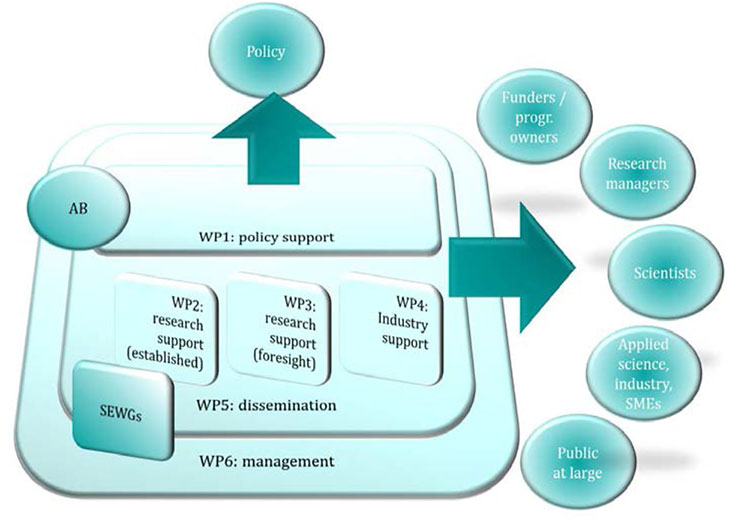As a follow-up project to BILAT USA 2.0, BILAT USA 4.0 aimed to strengthen the economic, research and innovation cooperation between the EU and the USA. BILAT USA 4.0 was a coordination and support measure (CSA) funded in the context of Horizon 2020, the current European Union Framework Programme for Research and Innovation. Focusing on the objective of an intensified EU-US cooperation, BILAT USA 4.0 enabled greater bi-regional exchange between scientists, researchers and innovation actors at conferences and work meetings with the aim of improving the framework conditions for the cooperation. It also comprised various studies and analyses of the status quo of research and innovation cooperation.
The project activities were split into six work packages, which in turn were divided into several sub-tasks:

Project structure of BILAT USA 4.0 (incl. target groups)
Work package 1 – “Supporting research and innovation policy processes”:
This work package covered flexible and adhoc support for political organisations and committees (such as the Strategy Forum for International Science and Technology Cooperation (SFIC), the harmonisation of European Commission funding programmes with those of the member states or associated states relevant to the USA as well as the attempt to set up a National Contact System (NKS) for applications to Horizon 2020 in the USA.
Work package 2 – “Funding the EU-US cooperation in prioritised science areas“:
Work package 2 related to funding for the prioritised EN-US cooperation areas, i.e. marine and Arctic research, health and transport research as well as nanotechnology and materials research. This work package organised at least six workshops and conferences in the above areas in order to offer scientists a forum for discussions and to draw their attention to the financing options. In addition, “Terminology Guidelines” was developed to overcome the linguistic differences in EU and US project funding.
Work package 3 – “Identification of new promising R&D topics for EU-US cooperation“:
In addition to the prioritised R&D areas of the EU-US cooperation, work package 3 focused on identifying new research and innovation topics with great potential. New fields with great potential and benefits for the EU-US cooperation were identified and discussed with scientists from the EU and the USA in workshops and at other events.
Work package 4 – “Innovation actors in the transatlantic R&D cooperation”
Work package 4 aimed to intensify the cooperation between academic actors and industry stakeholders added to the transatlantic internationalisation of companies using the following activities: identification, analysis and propagation of “best practices” for the EU-US cooperation of academia and industry, official visit clusters (topic-based) to the USA and Europe, the implementation of a funding announcement in order to bring together innovation actors from a specific area and to drive innovation cooperation.
Work package 5 – “Dissemination and communication”
Work package 5 aimed at developing an effective communication strategy and adequate means to distribute information. This e.g. included: developing a project website, using and setting up social media channels, providing a database with financing options for researchers and scientists, compiling newsletters, press releases etc.
Work package 6 – “Project management and quality assurance”:
Work package 6 looked at a financial and administrative project implementation and at standardised quality assurance for project activities, project reports and deliverables.







